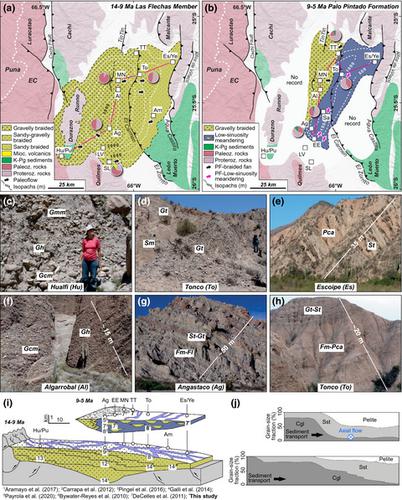当前位置:
X-MOL 学术
›
Basin Res.
›
论文详情
Our official English website, www.x-mol.net, welcomes your
feedback! (Note: you will need to create a separate account there.)
Stratigraphic response to fragmentation of the Miocene Andean foreland basin, NW Argentina
Basin Research ( IF 2.8 ) Pub Date : 2021-07-28 , DOI: 10.1111/bre.12589 Cecilia del Papa 1 , Patricio Payrola 2 , Heiko Pingel 3 , Fernando Hongn 2 , Margarita Do Campo 4 , Edward R. Sobel 3 , Ayelen Lapiana 1 , John Cottle 5 , Johannes Glodny 6 , Manfred R. Strecker 3
Basin Research ( IF 2.8 ) Pub Date : 2021-07-28 , DOI: 10.1111/bre.12589 Cecilia del Papa 1 , Patricio Payrola 2 , Heiko Pingel 3 , Fernando Hongn 2 , Margarita Do Campo 4 , Edward R. Sobel 3 , Ayelen Lapiana 1 , John Cottle 5 , Johannes Glodny 6 , Manfred R. Strecker 3
Affiliation

|
Foreland basins are sensitive recorders of spatiotemporal variations in tectonic and climatic forcing associated with an approaching orogenic front. Thus, analysis of foreland deposits and their associated deformation patterns and provenance signals allows assessment of tectonic and sedimentary processes during orogeny, providing clues to past environmental conditions. The Calchaquí region in the southern part of the northwest Argentinian Eastern Cordillera (ca. 25–26°S lat) structurally evolved from a contiguous Paleogene foreland of the Andes into a broken foreland and finally an intermontane basin landscape. This history is recorded in the sedimentary sequences of the Mio-Pliocene Angastaco and Palo Pintado Formations. We combine sedimentological methods, U-Pb zircon and K-Ar glass geochronology, clay mineralogy, and geochemical weathering indices with apatite fission track and (U-Th-Sm)/He thermochronology, structural data, and fault modelling to document the stratigraphic response to the fluvial and tectonic processes that followed the formation of the broken foreland. Our observations suggest that fluvial systems in the Calchaquí region repeatedly changed their location and geometry. These fluvial systems were associated with pro- and retrograding gravel wedges that most likely formed in response to the structural growth of the Aguas de Castilla and Altos de Viñaco ranges that bound the basin to the east. A compartmentalisation of the foreland with restricted fluvial networks must have occurred by ca. 9 Ma. Our results demonstrate that the reconstruction of stratigraphic architectures constitutes a powerful means to better understand intrabasin tectonics and surface uplift in foreland basins.
中文翻译:

阿根廷西北部中新世安第斯前陆盆地破碎的地层响应
前陆盆地是与接近的造山带相关的构造和气候强迫时空变化的敏感记录器。因此,对前陆沉积物及其相关变形模式和来源信号的分析可以评估造山运动期间的构造和沉积过程,为过去的环境条件提供线索。位于阿根廷东科迪勒拉西北部(约 25-26°S lat)南部的 Calchaquí 地区在结构上从安第斯山脉的连续古近纪前陆演化为破碎的前陆,最后是山间盆地景观。这段历史记录在 Mio-Pliocene Angastaco 和 Palo Pintado 地层的沉积层序中。我们结合了沉积学方法、U-Pb 锆石和 K-Ar 玻璃年代学、粘土矿物学、以及具有磷灰石裂变轨迹和 (U-Th-Sm)/He 热年代学、结构数据和断层模型的地球化学风化指数,以记录破碎前陆形成后河流和构造过程的地层响应。我们的观察表明,卡尔查基地区的河流系统反复改变了它们的位置和几何形状。这些河流系统与前积和后退砾石楔有关,这些砾石楔最有可能是响应将盆地与东部连接起来的阿瓜斯卡斯蒂利亚和阿尔托斯德维纳科山脉的结构增长而形成的。前陆与受限制的河流网络的划分必须发生在大约。9 马。
更新日期:2021-07-28
中文翻译:

阿根廷西北部中新世安第斯前陆盆地破碎的地层响应
前陆盆地是与接近的造山带相关的构造和气候强迫时空变化的敏感记录器。因此,对前陆沉积物及其相关变形模式和来源信号的分析可以评估造山运动期间的构造和沉积过程,为过去的环境条件提供线索。位于阿根廷东科迪勒拉西北部(约 25-26°S lat)南部的 Calchaquí 地区在结构上从安第斯山脉的连续古近纪前陆演化为破碎的前陆,最后是山间盆地景观。这段历史记录在 Mio-Pliocene Angastaco 和 Palo Pintado 地层的沉积层序中。我们结合了沉积学方法、U-Pb 锆石和 K-Ar 玻璃年代学、粘土矿物学、以及具有磷灰石裂变轨迹和 (U-Th-Sm)/He 热年代学、结构数据和断层模型的地球化学风化指数,以记录破碎前陆形成后河流和构造过程的地层响应。我们的观察表明,卡尔查基地区的河流系统反复改变了它们的位置和几何形状。这些河流系统与前积和后退砾石楔有关,这些砾石楔最有可能是响应将盆地与东部连接起来的阿瓜斯卡斯蒂利亚和阿尔托斯德维纳科山脉的结构增长而形成的。前陆与受限制的河流网络的划分必须发生在大约。9 马。











































 京公网安备 11010802027423号
京公网安备 11010802027423号